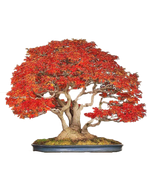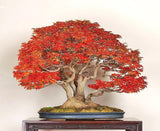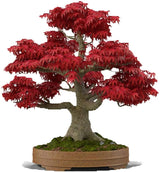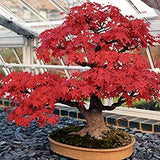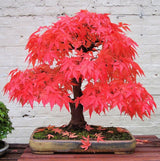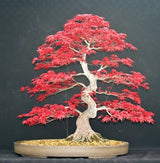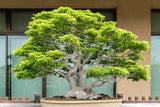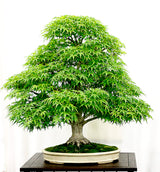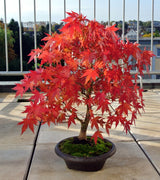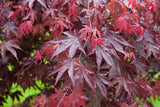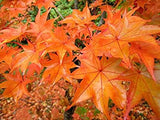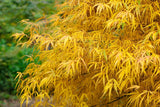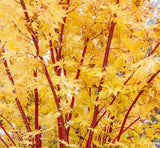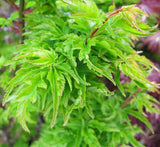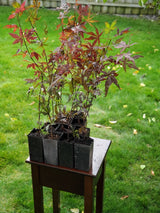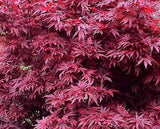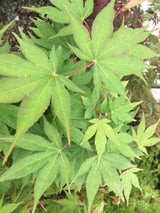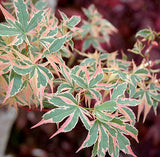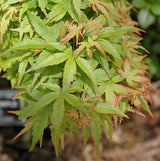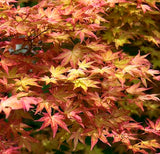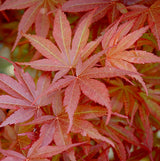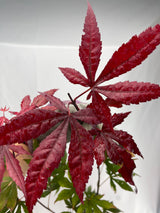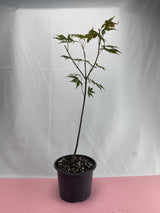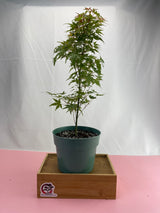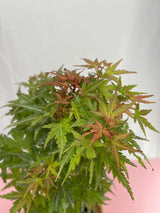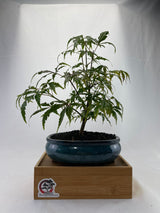Japanese Maple (Acer Palmatum + var)
The Royal Family of Bonsai,
The majestic Japanese Maple (Acer Palmatum) + (Acer Dissectum) is considered the king of Bonsai trees. It's complicated and vigorous growth compiled with small, colourful ornamental leaves. Make this tree both easy to grow and impressive when mature.
For the most part, Japanese Maples are of the more accessible varieties to grow as Bonsai.
But that's just the beginning as there are hundreds of magnificent cultivars this variety has.
Bloodgood

- Small flowers make way to red leaves, turning purple later in the summer and fall. When the leaves fall, they make visible the reddish-black trunk, having a very striking effect.
This purple leaf all-rounder that is both hardy and delicate is one of the most common and forgiving as a Bonsai.
Hogyoku

- This green-leafed tree looks impressive and compact, with thicker textured leaves that have a little curl to them. Its slow growth makes it an ideal Bonsai material. Midsummer, the leaves develop an orange edge. Come fall is where the bright pumpkin-coloured leaves make this variety stand out.
Koto No Ito

- Meaning: Golden Old Harp, this variety has delicate lace-like leaves that emerge dark red, turning green during growth and then a golden yellow in the fall. Slow growing and a semi-dwarf Acer cultivar make this an excellent choice for Bonsai.
Sango Kaku

- Famously known as Coral Bark Maple, for its striking bright red bark colour. Leaves start pinkish yellow in the spring, turning to soft green in the summer before turning a golden yellow in the fall. The unique bark colour accentuates the delicate leaves. This slow-growing cultivar is a very desirable specimen for Bonsai. Trying to describe this majestic tree in only one picture is impossible, so we added another of its summer colours.

Shishigashira

- The Lions Head Maple, one of if not the most desirable of the Japanese Maples for Bonsai. Tight leaf bunches that curl and are arranged in a cloud-like shape. Slow growing with a mesmerizing green bark. This cultivar is famous for attracting attention from anyone that happens to see it. When most other maples are losing their leaves and getting ready for the winter, the Shishigashira is still going strong, slowly changes its colouring to golden, crimson and rose hues. Once again, standing in a class of its own.

Beni Schichihenge

Sharps Pigmy
Sharp's Pygmy has attractive green foliage which variegates with pink in the spring. The small lobed palmate leaves are highly ornamental and turn outstanding shades of scarlet and orange in the fall. Very tight foliage makes this one of the most desirable cultivars for Bonsai.

Shindeshojo
Shindeshojo is renowned and considered the best among this species for its hot scarlet and red spring foliage which fades to greenish-bronze over the summer months. A real beauty with constantly changing foliage colours and takes very well to wire and pruning work.

Pixie
Pixie has attractive red foliage that is very similar to the Bloodgood in that they are bright red in spring and gradually change to deep red throughout the summer and bright scarlet in autumn. But unlike the Bloodgood, its nodes between leaves are shorter and the leaf density is much higher making this a truly outstanding option for Bonsai.

Dwarf Japanese Maple

- This exciting cultivar is highly sought after for Bonsai as it naturally slow-growing. In addition, Dwarf Japanese Maples* also have naturally small leaves, short internodes and abundant branching. Using this material for Bonsai is wonderful given the proportionate nature of the art. With small leaves, short internodes and low branching, your Dwarf Japanese Maple Bonsai will look like a large weathered maple in nature very quickly.




























